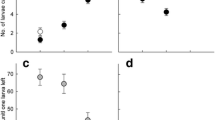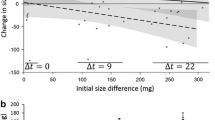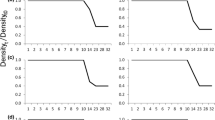Abstract
Cannibalism by larval damselflies late in larval development on larvae a few instars smaller has been widely documented. I examine here the survival of eggs oviposited near the end of the flight season of adult Enallagma boreale in the presence and absence of potential cannibals, individuals that hatched from eggs earlier in the season, over an extended part of the life-cycle. The role of competition as a modifier of cannibalism was examined by manipulating egg density, environmental productivity, and habitat complexity. Survival in the absence of potential cannibals ranged from 5% to nearly 50% but was only 0–3% in the presence of cannibals. Survival of small larvae was related to manipulations of habitat complexity but not initial density or resources. There were no significant interactions of the presence of large larvae with other experimental treatments on the survival of small larvae. The mean size of small larvae was greater in the presence of cannibals. This may be because the cannibalism treatment reduced the density of small larvae and reduced competition for resources, or that the cannibals preferentially fed on small larvae and only relatively large individuals remained. Fertilization of the habitat or manipulating the initial density of small larvae did not affect mass of small larvae at the end of the experiment, which would be expected if small larvae were affected by competition for resources. Potential cannibals, however, emerged at higher mass when small larvae were present at low density and when productivity of the habitat was increased. This suggests that the negative effect of competition by small larvae outweighs the positive effect of being potential prey for large larvae.
Similar content being viewed by others
References
Akre BG, Johnson DM (1979) Switching and sigmoid functional response curves by damselfly naiads with alternative prey available. J Anim Ecol 48:703–720
Anholt BR (1990) An experimental separation of interference and exploitative competition in a larval damselfly. Ecology 71:1483–1493
Anholt BR (1991) Measurements of selection of a population of damselflies with a manipulated phenotype. Evolution 45:1091–1106
Baker RL (1980) Use of space in relation to feeding areas by zygopteran nymphs in captivity. Can J Zool 58:1060–1065
Baker RL (1981) Behavioural interactions and use of feeding areas by nymphs of Coenagrion resolutum (Coenagrionidae: Odonata). Oecologia 49:353–358
Baker RL (1983) Spacing behaviour by larval Ischnura cervula Selys: effects of hunger, previous interactions, and familiarity with an area (Zygoptera: Coenagrionidae). Odonatogica 12:201–207
Baker RL, Clifford HF (1981) Life cycles and food of coenagrion resolutum (Coenagrionidae: Odonata) and Lestes disjunctus (Lestidae: Odonata) populations from the boreal forest of Alberta, Canada. Aquat Insects 3:179–191
Banks MJ, Thompson DJ (1985) Lifetime mating success in the damselfly Coenagrion puella. Anim Behav 33:1175–1183
Benke AC (1978) Interactions among coexisting predators — a field experiment with dragonfly larvae. J Anim Ecol 47:335–350
Fincke OM (1985) Alternative mate-finding tactics in a non-territorial damselfly (Odonata: Coenagrionidae). Anim Behav 33:1124–1137
Fincke OM (1986) Lifetime reproductive success and the opportunity for selection in a non-territorial damselfly (Odonota: Coenagrionidae). Evolution 40:791–803
Fincke OM (1988) Sources of variation in lifetime reproductive success in a non-territorial damselfly. In: Clutton-Brock TH (ed) Reproductive success. University of Chicago Press, Chicago, Illinois, pp 24–43
Fox L (1975) Cannibalism in natural populations. Annu Rev Ecol Syst 6:87–106
Goldberg DE (1990) Components of resource competition in plant communities. In: Grace J, Tilman D (eds) Perspectives on plant competition. Academic Press, New York, pp 27–49
Gribbin SD, Thompson DJ (1990) Asymmetric intraspecific competition among larvae of the damselfly Ischnura elegans (Zygoptera: Coenagrionidae). Ecol Entomol 15:37–42
Gribbin SD, Thompson DJ (1991) Emergence of the damselfly Pyrrhosoma nymphula (Sulzer) (Zygoptera: Coenagrionidae) from two adjacent ponds in northern England. Hydrobiologia 209:123–131
Hartigan JA, Wong MA (1975) A K-means clustering algorithm: Algorithm AS 136. Appl Stat 28:126–130
Healy MJR (1988) GLIM: an introduction (Oxford Science Publications) Clarendon Press, Oxford
Johansson F (1992) Effects of zooplankton availability and foraging mode on cannibalism in three dragonfly larvae. Oecologia 91:179–183
Johnson DM (1991) Behavioural ecology of larval dragonflies and damselflies. Trends Ecol Evol 6:8–13
Johnson EM, Crowley PH, Bohanan RE, Watson CN, Martin TH (1985) Competition among larval dragonflies: a field enclosure experiment. Ecology 66:119–128
Lawton JH (1970) A population study on larvae of the damselfly Pyrrhosoma nymphula (Sulzer) (Odonata: Zygoptera). Hydrobiologia 36:33–52
Lawton JH, Thompson BA, Thompson DJ (1980) The effects of prey density on survival and growth of damselfly larvae. Ecol Entomol 5:39–51
Martin TH (1991) Fish-mediated alternative life-history strategies in the dragonfly Epitheca cynosura. J N Am Benthol Soc 10:271–279
McIsaac HJ, JJ Gilbert (1991) Discrimination between exploitative and interference competition between Cladocera and Keratella cochlearis. Ecology 72:924–937
McPeek MA, Crowley PH (1987) The effects of density and relative size on the aggressive behavior, movement and feeding of damselfly larvae (Odonata: Coenagrionidae). Anim Behav 35:1051–1061
Mead R (1988) The design of experiments: statistical principles for practical application. Cambridge University Press, Cambridge
Neill WE (1978) Experimental studies on factors limiting colonization by Daphnia pulex Leydig of coastal montane lakes in British Columbia. Can J Zool 56:2498–2507
Neill WE (1984) Regulation of rotifer densities by crustacean zooplankton in an oligotrophic montane lake in British Columbia. Oecologia 61:175–181
Norling U (1984) Life history patterns in the northern expansion of dragonflies. Adv Odonatol 2:127–156
Numerical Algorithms Group (1987) Generalized linear interactive modelling system: manual release 3.77-ed 2. NAG, Oxford
Polis GA (1981) The evolution and dynamics of intraspecific predation. Annu Rev Ecol Syst 12:225–251
Polis GA, Myers CA, Holt RD (1989) The ecology and evolution of inraguild predation: potential competitors that eat each other. Annu Rev Ecol Syst 20:297–330
Rowe L, Ludwig D (1991) Size and timing of metamorphosis in complex life cycles: time constraints and variation. Ecology 72:413–427
Rowe RJ (1980) Territorial behaviour of a larval dragonfly Xanthocnemis zealandica (MacLachlan) (Zygoptera: Coenarionidae). Odonatologica 9:285–292
Schoener TW (1973) Population growth regulated by intraspecific competition for energy or time: some simple representations. Theor Popul Biol 4:56–84
Thompson DJ (1978) Towards a realistic predator-prey model: the effect of temperature on the functional response and life history of larvae of the damselfly, Ischnura elegans. J Anim Ecol 47:757–767
Thompson DJ (1987) Regulation of damselfly populations: the effects of weed density on larval mortality due to predation. Freshwater Biol 17:367–371
Underwood AJ (1986) The analysis of competition by field experiments. In: Kikkawa J, Anderson DJ (eds) Community ecology: pattern and process, Blackwell Scientific, London, pp 240–260
Van Buskirk J (1989) Density-dependent cannibalism in larval dragonflies. Ecology 70:1442–1449
Vannote RL, BW Sweeney (1980) Geographic analysis of thermal equilibria: a conceptual model for evaluating the effect of natural and modified thermal regimes on aquatic insect communities. Am Nat 115:667–695
Werner EE (1994) Ontogenetic scaling of competitive relations: size-dependent effects and responses in two anuran larvae. Ecology 75:197–213
Werner EE, Gilliam JF (1984) The ontogenetic niche and species interactions in size-structured populations. Annu Rev Ecol Syst 15:393–425
Wilkinson L (1988) SYSTAT: The system for statistics. SYSTAT Inc, Evanston
Wissinger SA (1988) Effects of food availability on larval development and inter-instar predation among larvae of Libellula lydia and Libellula luctuosa (Odonata: Anisoptera). Can J Zool 66:543–549
Wissinger SA (1989) Seasonal variation in the intensity of competition and predation among dragonfly larvae. Ecology 70:1017–1027
Wissinger SA (1992) Niche overlap and the potential for competition and intraguild preation between size-structured populations. Ecology 73:1431–1444
Zar JH (1984) Biostatistical analysis, 2nd edn. Prentice-Hall, Englewood Cliffs
Author information
Authors and Affiliations
Rights and permissions
About this article
Cite this article
Anholt, B.R. Cannibalism and early instar survival in a larval damselfly. Oecologia 99, 60–65 (1994). https://doi.org/10.1007/BF00317083
Received:
Accepted:
Issue Date:
DOI: https://doi.org/10.1007/BF00317083




